Photographing wildlife ethically in the park involves respecting animals and their habitats while capturing stunning images, and SIXT.VN can help you plan your trip responsibly. By following guidelines that minimize disturbance and prioritize the well-being of wildlife, you can ensure your photography contributes to conservation rather than harm. This includes maintaining a safe distance, avoiding baiting, and being mindful of breeding seasons. With ethical wildlife photography, you’ll protect our environment, wildlife watching, and habitat preservation.
1. What is Ethical Wildlife Photography?
Ethical wildlife photography prioritizes the well-being of animals and their habitats over capturing the “perfect shot”. It involves understanding and respecting wildlife behavior, minimizing disturbance, and adhering to guidelines that promote conservation. Ethical wildlife photography ensures the photography does not harm or stress animals, maintains the integrity of their environment, and respects local regulations and guidelines.
- Respecting Animal Behavior: Understanding how animals react to human presence is crucial. Avoid actions that cause stress, alter natural behaviors, or disrupt their environment.
- Minimizing Disturbance: This includes keeping a safe distance, avoiding loud noises, and refraining from using flash photography that can disorient or scare animals.
- Promoting Conservation: Ethical photographers often use their work to raise awareness about conservation issues and support organizations dedicated to protecting wildlife and their habitats.
2. Why is Ethical Wildlife Photography Important?
Ethical wildlife photography is vital for several reasons. Primarily, it protects the well-being of animals and their environments. By adhering to ethical guidelines, photographers minimize disturbance, stress, and potential harm to wildlife. Furthermore, ethical photography supports conservation efforts by promoting respect for nature and raising awareness about environmental issues.
- Protecting Animal Welfare: Unethical practices can cause significant stress and harm to animals, affecting their feeding, breeding, and overall survival.
- Preserving Natural Behaviors: Disturbing wildlife can alter their natural behaviors, making them more vulnerable to predators or disrupting their social structures.
- Supporting Conservation Efforts: Ethical photographers contribute to conservation by educating the public and inspiring others to respect and protect wildlife.
3. What are the Key Principles of Ethical Wildlife Photography?
The core principles of ethical wildlife photography revolve around minimizing disturbance, respecting wildlife, and promoting conservation. These principles include maintaining a safe distance, avoiding baiting and luring, respecting habitats, and adhering to local regulations. By following these guidelines, photographers can ensure their work does not negatively impact the subjects they photograph.
- Maintain a Safe Distance: Use telephoto lenses to capture images from a distance, reducing the risk of disturbing animals.
- Avoid Baiting and Luring: Do not use food or other attractants to bring animals closer, as this can disrupt their natural foraging behaviors.
- Respect Habitats: Stay on marked trails, avoid damaging vegetation, and minimize your impact on the environment.
4. How Can You Minimize Disturbance to Wildlife While Photographing?
Minimizing disturbance is key to ethical wildlife photography. This involves several strategies, including using appropriate equipment, understanding animal behavior, and being patient. By observing wildlife from a distance, avoiding sudden movements and loud noises, and respecting their space, photographers can reduce stress on animals and capture more natural, authentic images.
- Use Telephoto Lenses: These allow you to photograph wildlife from a distance, minimizing disturbance.
- Understand Animal Behavior: Learn to recognize signs of stress or discomfort in animals, such as changes in body language or vocalizations.
- Be Patient: Wait for animals to behave naturally rather than trying to force interactions or capture specific poses.
5. What Equipment is Best for Ethical Wildlife Photography?
Choosing the right equipment can significantly enhance your ability to photograph wildlife ethically. Telephoto lenses are essential for maintaining a safe distance, while binoculars and spotting scopes can help you observe animals without getting too close. Additionally, using camera settings that allow for low-light photography can reduce the need for flash, which can startle or disorient animals.
- Telephoto Lenses: These lenses allow you to capture detailed images from a distance, reducing the risk of disturbance.
- Binoculars and Spotting Scopes: These tools enable you to observe wildlife from afar, helping you assess their behavior and plan your approach.
- Low-Light Camera Settings: Using high ISO settings and fast lenses can help you capture images in low-light conditions without using flash.
6. What are the Best Practices for Approaching Wildlife?
Approaching wildlife requires a cautious and respectful approach. Always move slowly and deliberately, avoiding sudden movements that could startle animals. Observe their behavior and body language to gauge their comfort level, and be prepared to retreat if they show signs of stress.
- Move Slowly and Deliberately: Avoid sudden movements that could startle animals.
- Observe Animal Behavior: Watch for signs of stress or discomfort, such as changes in body language or vocalizations.
- Be Prepared to Retreat: If an animal shows signs of distress, back away slowly and give it space.
7. How Does Baiting and Luring Affect Wildlife?
Baiting and luring can have detrimental effects on wildlife. Providing food can disrupt natural foraging behaviors, making animals dependent on humans and altering their diets. It can also increase the risk of disease transmission and attract animals to dangerous areas, such as roads.
- Disrupts Natural Foraging Behaviors: Animals may become dependent on humans for food, reducing their ability to find food on their own.
- Increases Risk of Disease Transmission: Concentrating animals in one area can increase the spread of diseases.
- Attracts Animals to Dangerous Areas: Animals may be drawn to roads or other hazardous locations in search of food.
8. What are the Ethical Considerations During Breeding Seasons?
Breeding seasons are particularly sensitive times for wildlife. Animals are more vulnerable and easily stressed, and disturbances can have serious consequences for their reproductive success. During these times, it’s especially important to maintain a safe distance, avoid approaching nests or dens, and minimize any activities that could disrupt breeding behaviors.
- Maintain a Safe Distance: Avoid approaching nests or dens, as this can cause stress and abandonment.
- Minimize Disturbance: Reduce noise levels and avoid any activities that could disrupt breeding behaviors.
- Respect Protected Areas: Adhere to any closures or restrictions in place to protect breeding wildlife.
9. How Can You Promote Ethical Wildlife Photography on Social Media?
Social media can be a powerful tool for promoting ethical wildlife photography. By sharing images that showcase respect for wildlife and their habitats, you can inspire others to adopt ethical practices. Additionally, consider including information about ethical guidelines and conservation efforts in your posts to raise awareness and encourage responsible behavior.
- Share Respectful Images: Showcase images that highlight natural behaviors and minimize signs of disturbance.
- Include Ethical Guidelines: Share information about ethical photography practices in your posts.
- Promote Conservation Efforts: Support and promote organizations dedicated to protecting wildlife and their habitats.
10. How Can SIXT.VN Help You Plan an Ethical Wildlife Photography Trip in Vietnam?
Planning a wildlife photography trip to Vietnam requires careful consideration of ethical practices. SIXT.VN offers services that can help you plan a responsible and respectful trip, ensuring you minimize your impact on wildlife and their habitats.
- Consultation on Ethical Practices: SIXT.VN can provide guidance on ethical photography practices specific to Vietnam’s wildlife and protected areas.
- Transportation Services: SIXT.VN offers reliable transportation options, ensuring you can access remote locations with minimal environmental impact.
- Accommodation Bookings: SIXT.VN can help you find eco-friendly accommodations that prioritize sustainability and conservation.
- Guided Tours: SIXT.VN offers guided tours led by knowledgeable locals who can provide insights into wildlife behavior and conservation efforts.
- Permits and Regulations: SIXT.VN can assist with obtaining necessary permits and understanding local regulations related to wildlife photography.
By choosing SIXT.VN, you can ensure your wildlife photography trip to Vietnam is both memorable and ethical, contributing to the preservation of the country’s natural heritage.
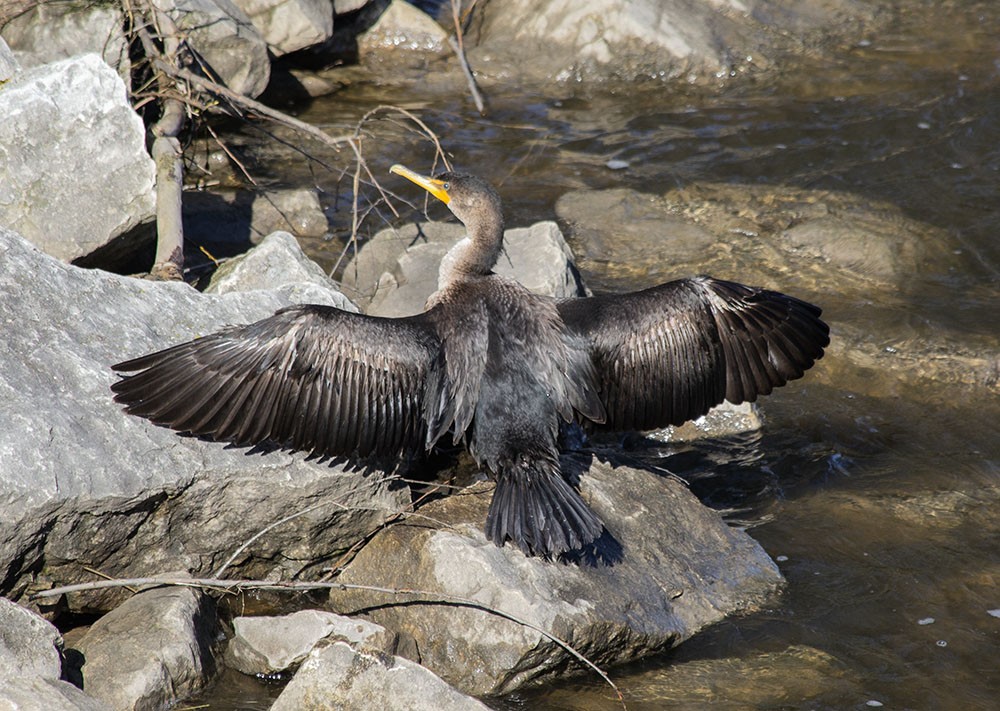 A cormorant drying its wings on the Milwaukee River Greenway, captured from a pedestrian bridge, showcasing ethical wildlife observation from a distance.
A cormorant drying its wings on the Milwaukee River Greenway, captured from a pedestrian bridge, showcasing ethical wildlife observation from a distance.
11. Understanding the Impact of Your Presence on Wildlife
When you enter the habitat of wild animals, your presence can have a significant impact, even if unintended. Animals are naturally wary of humans, and your approach can trigger stress responses that affect their behavior and well-being. Understanding these potential impacts is crucial for practicing ethical wildlife photography.
11.1 Stress Responses in Wildlife
Animals respond to perceived threats in various ways, often activating their “fight or flight” response. This physiological reaction prepares them to either confront the threat or escape from it. In either case, it expends valuable energy and can disrupt essential activities like feeding, resting, and breeding.
- Elevated Heart Rate: Increased heart rate prepares the animal for physical exertion.
- Increased Respiration: Rapid breathing delivers more oxygen to muscles.
- Release of Stress Hormones: Hormones like cortisol flood the bloodstream, preparing the body for action but also suppressing immune function.
11.2 Altered Behavior Patterns
The presence of humans can cause animals to change their behavior in several ways. They may become more vigilant, spending more time scanning their surroundings for threats and less time foraging or caring for their young. In extreme cases, animals may abandon their territory altogether.
- Increased Vigilance: Animals become hyper-aware of their surroundings.
- Reduced Foraging: Animals spend less time searching for food.
- Territorial Abandonment: Animals may leave their habitat to avoid human interaction.
11.3 Impact on Reproduction
Breeding animals are particularly susceptible to disturbance. Stress can disrupt mating rituals, cause parents to abandon nests or young, and reduce overall reproductive success. Ethical photographers take extra care to avoid breeding areas during sensitive times.
- Disrupted Mating Rituals: Stress can interfere with courtship and mating behaviors.
- Nest Abandonment: Parents may abandon nests or dens if they feel threatened.
- Reduced Reproductive Success: Overall, stress can lower the number of offspring that survive.
11.4 Habituation and Dependence
While it may seem harmless, frequent exposure to humans can lead to habituation, where animals become desensitized to human presence. This can make them bolder and more likely to approach people, increasing the risk of conflicts. In some cases, animals may even become dependent on humans for food, disrupting their natural foraging behaviors.
- Increased Boldness: Animals may lose their natural fear of humans.
- Higher Risk of Conflicts: Animals may approach people more often, leading to potential conflicts.
- Dependence on Humans: Animals may rely on humans for food, disrupting natural foraging behaviors.
By understanding these potential impacts, you can take steps to minimize your footprint and photograph wildlife in a way that respects their well-being.
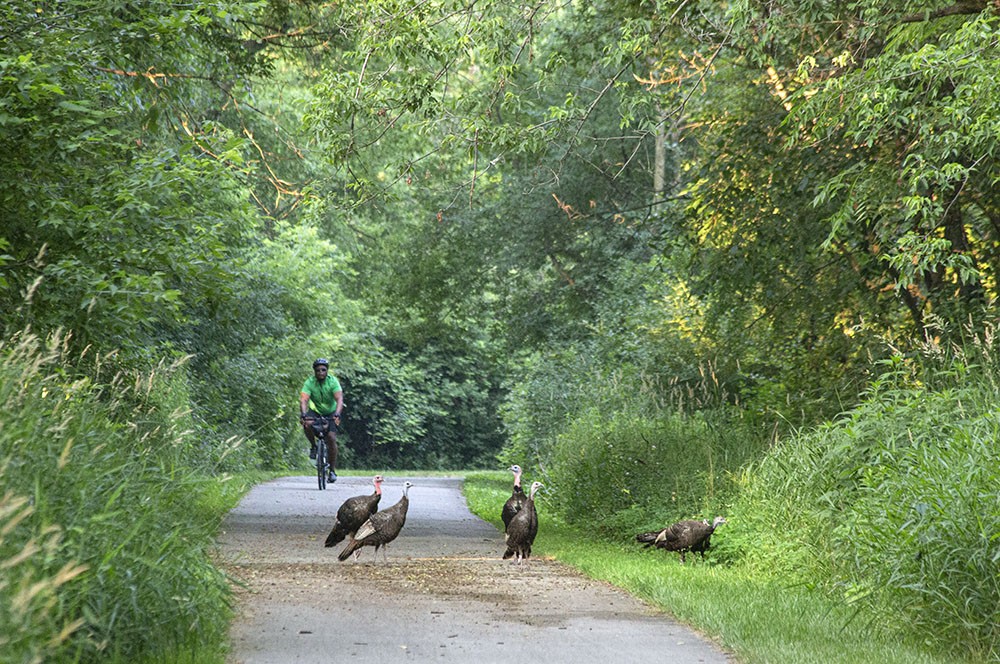 Turkeys on the Oak Leaf Trail, observed ethically by waiting patiently for the right moment without disturbing their natural behavior.
Turkeys on the Oak Leaf Trail, observed ethically by waiting patiently for the right moment without disturbing their natural behavior.
12. Techniques for Capturing Natural Wildlife Behavior
One of the most rewarding aspects of wildlife photography is capturing animals behaving naturally in their environment. This requires patience, skill, and a deep understanding of animal behavior. Here are some techniques to help you capture authentic moments while minimizing disturbance.
12.1 Patience and Observation
The key to capturing natural behavior is patience. Spend time observing your subjects before you even pick up your camera. Learn their habits, routines, and social dynamics. The more you know about their behavior, the better you’ll be able to anticipate and capture key moments.
- Arrive Early: Be in place before sunrise to capture animals as they wake up and begin their daily activities.
- Stay Quiet: Avoid making loud noises or sudden movements that could scare animals away.
- Use a Blind: A blind or hide can conceal your presence and allow you to observe animals without being detected.
12.2 Using Natural Light
Natural light can dramatically enhance your wildlife photos. Early morning and late afternoon light is often the most flattering, creating warm, soft tones that bring out the details in your subjects. Avoid harsh midday light, which can create strong shadows and wash out colors.
- Golden Hour: The hour after sunrise and the hour before sunset provide the best lighting conditions.
- Overcast Days: Overcast days can provide soft, even lighting that is ideal for capturing details.
- Backlighting: Shooting with the sun behind your subject can create a dramatic silhouette effect.
12.3 Avoiding Artificial Lighting
While artificial lighting can be tempting, it can also be disruptive and harmful to wildlife. Flash photography can startle animals, disorient them, and even damage their eyes. If possible, avoid using flash altogether. If you must use it, use it sparingly and with caution.
- Use a Red Filter: A red filter can reduce the intensity of the flash and make it less jarring to animals.
- Bounce the Flash: Bouncing the flash off a nearby surface can soften the light and reduce its intensity.
- Use a Continuous Light Source: A continuous light source, such as an LED panel, can provide more even and less disruptive illumination.
12.4 Capturing Action Shots
Action shots can add excitement and drama to your wildlife photos. Whether it’s a bird taking flight, a predator stalking its prey, or a playful interaction between animals, capturing these moments requires quick reflexes and a fast shutter speed.
- Use a Fast Shutter Speed: A fast shutter speed (1/500th of a second or faster) can freeze motion and prevent blur.
- Use Continuous Shooting Mode: Continuous shooting mode allows you to capture a burst of images in rapid succession, increasing your chances of capturing the perfect moment.
- Anticipate the Action: Watch for cues that an animal is about to move, such as a change in posture or a shift in gaze.
By following these techniques, you can capture stunning images of wildlife behaving naturally while minimizing disturbance and respecting their well-being.
 A little green heron at Jacobus Park, captured ethically by observing and photographing from a distance along a park path.
A little green heron at Jacobus Park, captured ethically by observing and photographing from a distance along a park path.
13. Understanding Wildlife Habitats in Vietnamese Parks
Vietnam boasts a remarkable diversity of wildlife habitats, ranging from lush rainforests and mangrove forests to expansive wetlands and rugged mountains. Each of these habitats supports a unique array of species, and understanding their characteristics is essential for ethical wildlife photography.
13.1 National Parks and Protected Areas
Vietnam has a network of national parks and protected areas that safeguard critical habitats and biodiversity. These areas offer some of the best opportunities for wildlife photography, but they also come with specific regulations and guidelines that must be followed.
- Cuc Phuong National Park: One of Vietnam’s oldest and most famous national parks, Cuc Phuong is home to a wide variety of primates, birds, and reptiles.
- Cat Tien National Park: Located in southern Vietnam, Cat Tien is a lowland tropical rainforest that supports a diverse range of mammals, including elephants, gaurs, and primates.
- Phong Nha-Ke Bang National Park: Known for its stunning cave systems and karst landscapes, Phong Nha-Ke Bang is also home to a variety of wildlife, including primates, ungulates, and birds.
13.2 Rainforest Ecosystems
Vietnam’s rainforests are biodiversity hotspots, teeming with life at every level. These ecosystems are characterized by high rainfall, warm temperatures, and dense vegetation. They support a wide variety of species, from colorful birds and butterflies to elusive mammals and reptiles.
- Canopy Layer: The upper layer of the rainforest, where most of the sunlight is intercepted, supports a rich array of arboreal species, including primates, birds, and insects.
- Understory Layer: The layer beneath the canopy, characterized by shade-tolerant plants and shrubs, provides habitat for many smaller animals, such as reptiles, amphibians, and small mammals.
- Forest Floor: The dimly lit forest floor is home to decomposers, insects, and larger mammals that feed on fallen leaves and fruits.
13.3 Wetland Environments
Vietnam’s wetlands, including mangrove forests, swamps, and marshes, are vital habitats for a variety of aquatic and semi-aquatic species. These ecosystems provide critical breeding and feeding grounds for migratory birds, fish, and crustaceans.
- Mangrove Forests: Coastal forests that are adapted to saltwater environments, providing habitat for fish, crabs, birds, and reptiles.
- Swamps: Wetlands dominated by trees and shrubs, providing habitat for amphibians, reptiles, birds, and mammals.
- Marshes: Wetlands dominated by grasses and reeds, providing habitat for birds, insects, and amphibians.
13.4 Mountainous Regions
Vietnam’s mountainous regions are home to a variety of unique species that are adapted to high altitudes and rugged terrain. These areas provide habitat for specialized plants and animals, including primates, ungulates, and birds.
- High-Altitude Forests: Forests that are adapted to cold temperatures and thin soils, providing habitat for specialized plants and animals.
- Alpine Meadows: Open grasslands above the treeline, providing habitat for grazing animals and birds.
- Rocky Outcrops: Cliffs and rocky areas that provide habitat for reptiles, birds, and small mammals.
By understanding the characteristics of these different habitats, you can better appreciate the diversity of Vietnam’s wildlife and plan your photography trips in a way that minimizes disturbance and respects the environment.
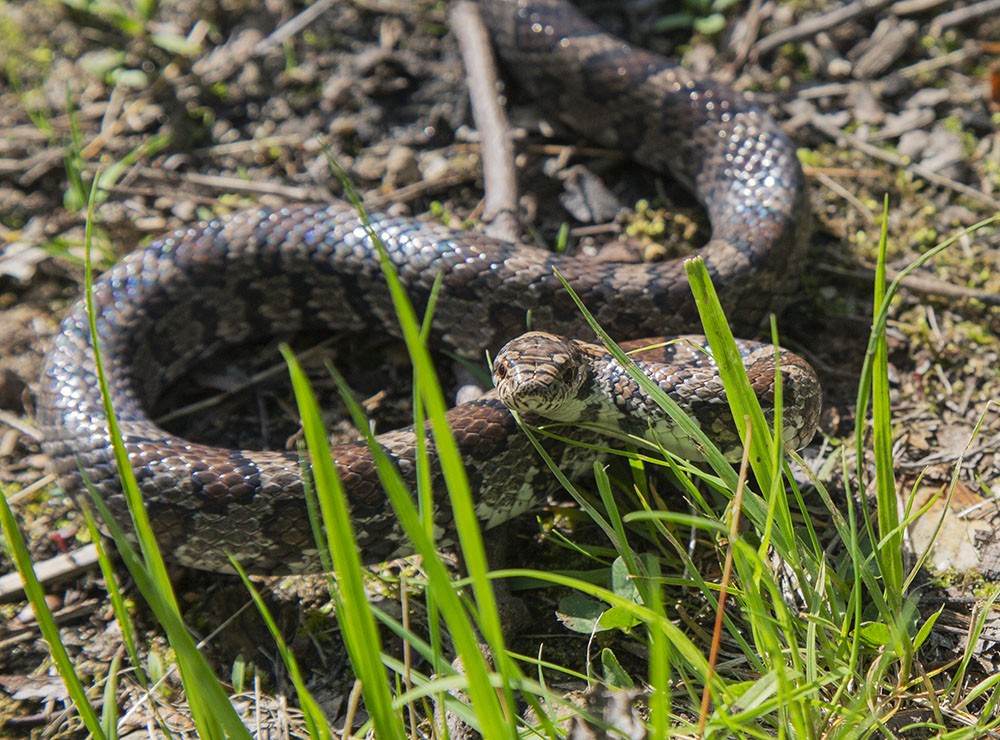 A milk snake at Lac Lawrann Conservancy, photographed carefully to avoid disturbing its natural habitat.
A milk snake at Lac Lawrann Conservancy, photographed carefully to avoid disturbing its natural habitat.
14. Local Regulations and Permits for Wildlife Photography in Vietnam
Before embarking on a wildlife photography trip in Vietnam, it’s essential to familiarize yourself with local regulations and obtain any necessary permits. These regulations are in place to protect wildlife and their habitats, and failure to comply can result in fines or other penalties.
14.1 National Park Regulations
Each national park in Vietnam has its own set of regulations regarding access, activities, and photography. These regulations may include restrictions on off-trail hiking, camping, and the use of drones. It’s important to check with the park authorities before your visit to ensure you are in compliance.
- Permit Requirements: Some national parks require permits for entry or specific activities, such as photography.
- Restricted Areas: Certain areas within the park may be off-limits to visitors to protect sensitive wildlife habitats.
- Code of Conduct: Visitors are expected to follow a code of conduct that promotes responsible behavior and minimizes disturbance to wildlife.
14.2 Protected Species Regulations
Vietnam has strict laws protecting certain species of wildlife, including endangered and threatened animals. It’s illegal to harm, harass, or disturb these species, and photography activities must be conducted in a way that does not violate these laws.
- Endangered Species List: Familiarize yourself with the list of endangered species in Vietnam and take extra precautions to avoid disturbing them.
- Habitat Protection: Avoid damaging or destroying the habitats of protected species.
- Reporting Requirements: If you encounter a protected species, you may be required to report your sighting to the authorities.
14.3 Community-Based Tourism Regulations
In some areas of Vietnam, community-based tourism initiatives are in place to promote sustainable tourism and support local communities. These initiatives may have their own regulations regarding wildlife photography, such as restrictions on the use of flash photography or the sharing of locations on social media.
- Respect Local Customs: Be respectful of local customs and traditions when interacting with communities.
- Support Local Businesses: Choose to patronize local businesses that are committed to sustainable tourism practices.
- Follow Community Guidelines: Adhere to any guidelines or regulations established by the community regarding wildlife photography.
14.4 Obtaining Permits
Obtaining the necessary permits for wildlife photography in Vietnam can be a complex process. It’s best to start planning well in advance and seek assistance from local tour operators or guides who are familiar with the regulations and procedures.
- Contact National Park Authorities: Contact the authorities in the national park you plan to visit to inquire about permit requirements.
- Work with Local Guides: Hire a local guide who can assist you with obtaining permits and navigating the regulations.
- Allow Sufficient Time: The permit application process can take several weeks or even months, so be sure to allow sufficient time.
By understanding and complying with local regulations and obtaining the necessary permits, you can ensure that your wildlife photography trip in Vietnam is both ethical and legal.
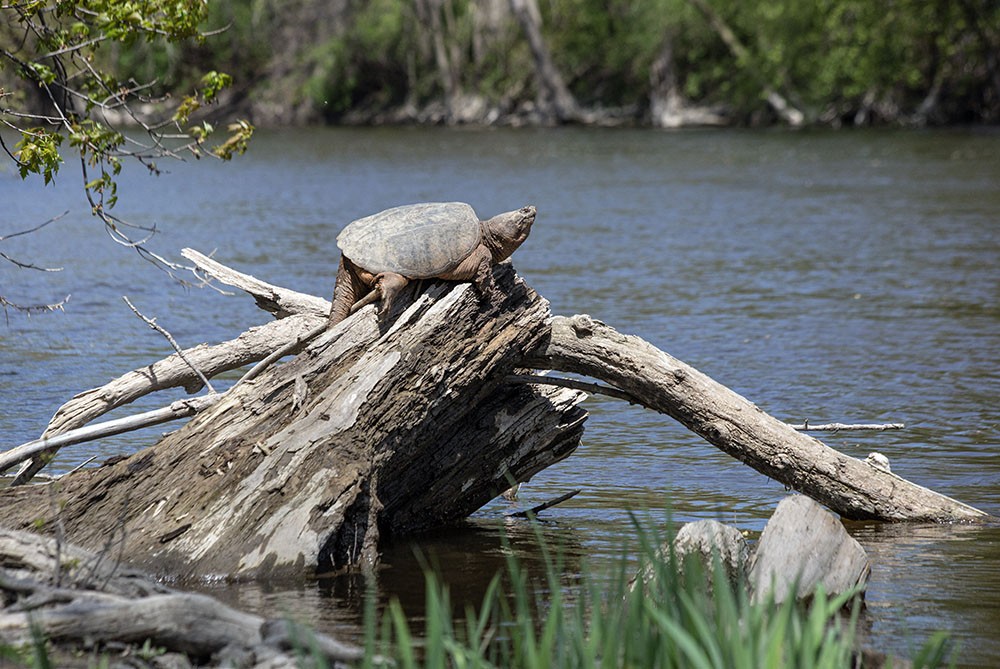 A snapping turtle sunning on the Mequon-Thiensville Riverwalk, observed responsibly from a boardwalk to minimize disturbance.
A snapping turtle sunning on the Mequon-Thiensville Riverwalk, observed responsibly from a boardwalk to minimize disturbance.
15. Ethical Considerations for Drone Photography of Wildlife
Drone photography has become increasingly popular in recent years, offering new perspectives on wildlife and their habitats. However, it also raises significant ethical concerns, as drones can disturb animals, disrupt their behavior, and even cause them harm. Here are some ethical considerations to keep in mind when using drones for wildlife photography.
15.1 Minimizing Disturbance
The noise and visual presence of drones can be highly disturbing to wildlife. Animals may perceive drones as predators and react with fear or aggression. To minimize disturbance, it’s important to maintain a safe distance and avoid flying drones too close to animals.
- Maintain a Safe Distance: Keep your drone at least 100 meters away from wildlife.
- Avoid Sensitive Areas: Avoid flying drones over nesting sites, breeding areas, or other sensitive habitats.
- Monitor Animal Behavior: Watch for signs of stress or disturbance in animals, such as changes in behavior or vocalizations.
15.2 Respecting Privacy
Wildlife has a right to privacy, just like humans. Avoid using drones to spy on animals or intrude on their personal space. Respect their natural behaviors and avoid capturing images that could be considered intrusive or exploitative.
- Avoid Close-Ups: Avoid capturing close-up images of animals without their knowledge or consent.
- Respect Natural Behaviors: Avoid disrupting natural behaviors, such as feeding, mating, or resting.
- Obtain Permission: If you plan to fly a drone over private property, obtain permission from the landowner first.
15.3 Complying with Regulations
Many countries and regions have regulations regarding the use of drones, including restrictions on where you can fly and how high you can go. It’s important to familiarize yourself with these regulations before you start flying your drone.
- Register Your Drone: Register your drone with the appropriate authorities.
- Obtain a License: Obtain a license or permit if required.
- Follow Airspace Regulations: Follow all airspace regulations and avoid flying in restricted areas.
15.4 Using Drones for Conservation
While drones can pose risks to wildlife, they can also be used for conservation purposes. Drones can be used to monitor wildlife populations, track animal movements, and assess habitat conditions. By using drones responsibly and ethically, you can contribute to the protection of wildlife and their habitats.
- Monitor Wildlife Populations: Use drones to count animals and track population trends.
- Track Animal Movements: Use drones to track animal movements and study their behavior.
- Assess Habitat Conditions: Use drones to assess habitat conditions and identify areas that need protection.
By following these ethical considerations, you can use drones to capture stunning images of wildlife while minimizing disturbance and respecting their well-being.
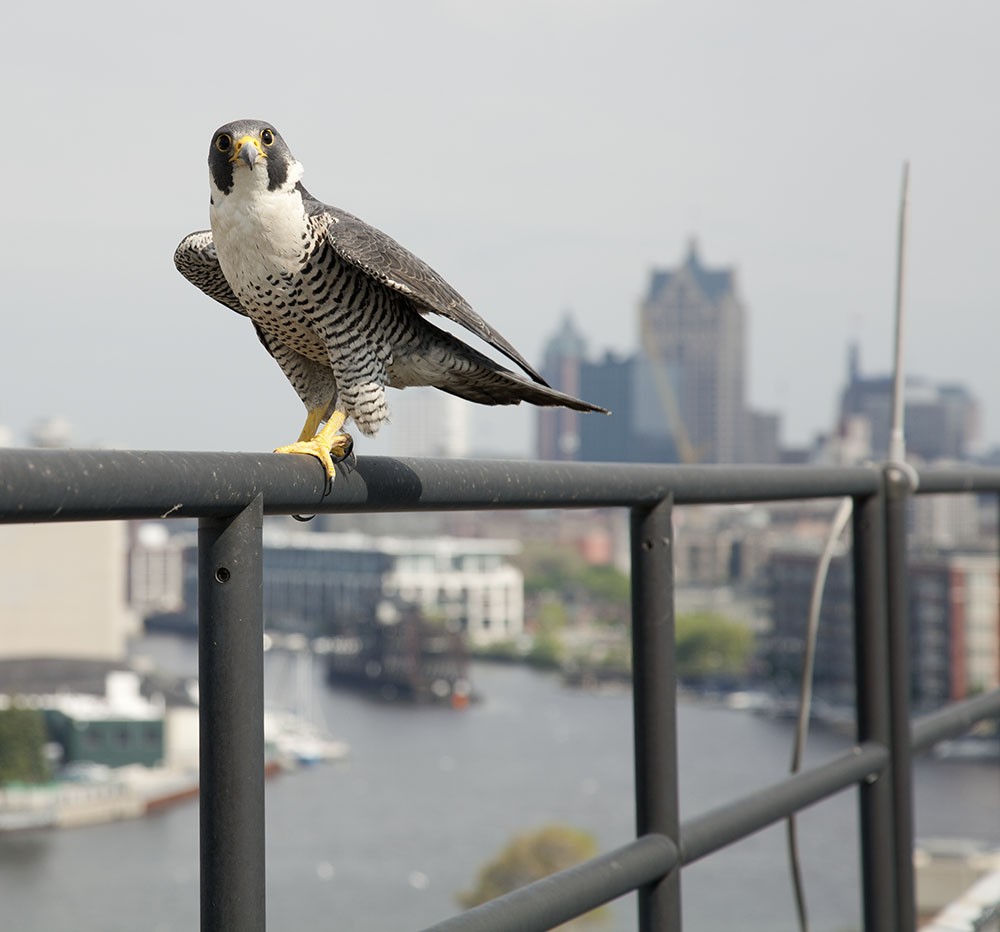 A peregrine falcon perched atop the Veolia building, photographed with permission and ethical consideration for its urban environment.
A peregrine falcon perched atop the Veolia building, photographed with permission and ethical consideration for its urban environment.
16. Case Studies of Ethical Wildlife Photography Projects
To further illustrate the principles of ethical wildlife photography, let’s examine some case studies of projects that have successfully balanced photography with conservation.
16.1 The International League of Conservation Photographers (ILCP)
The ILCP is an organization that brings together some of the world’s leading conservation photographers. Their mission is to use photography to promote conservation and raise awareness about environmental issues. ILCP photographers adhere to a strict code of ethics that prioritizes the well-being of wildlife and their habitats.
- Conservation Focus: ILCP photographers use their work to support conservation efforts and advocate for environmental protection.
- Ethical Guidelines: ILCP photographers adhere to a strict code of ethics that minimizes disturbance to wildlife.
- Education and Outreach: ILCP photographers educate the public about conservation issues through their images and stories.
16.2 The Wildlife Photographer of the Year Competition
The Wildlife Photographer of the Year competition, organized by the Natural History Museum in London, is one of the world’s most prestigious wildlife photography competitions. The competition has strict ethical guidelines that prohibit baiting, luring, and other practices that could harm wildlife.
- Ethical Judging Criteria: The competition judges entries based on ethical considerations, as well as technical skill and artistic merit.
- Promoting Responsible Photography: The competition promotes responsible wildlife photography practices through its guidelines and educational materials.
- Raising Awareness: The competition raises awareness about conservation issues through its exhibitions and publications.
16.3 Conservation Photography in Gorongosa National Park
Gorongosa National Park in Mozambique has been the site of a long-term conservation photography project led by American photographer Piotr Naskrecki. Naskrecki has worked closely with park authorities and local communities to document the park’s wildlife and promote conservation efforts.
- Long-Term Commitment: Naskrecki has dedicated years to documenting the wildlife of Gorongosa National Park.
- Community Involvement: Naskrecki has worked closely with local communities to promote sustainable tourism and conservation.
- Scientific Collaboration: Naskrecki has collaborated with scientists to study the park’s wildlife and assess the impact of conservation efforts.
These case studies demonstrate that it’s possible to create stunning wildlife photography while adhering to ethical principles and contributing to conservation efforts. By following their example, you can make a positive impact on the world through your photography.
 A swallowtail butterfly at Tendick Nature Park, photographed without baiting, relying on the natural allure of the swamp milkweed blossoms.
A swallowtail butterfly at Tendick Nature Park, photographed without baiting, relying on the natural allure of the swamp milkweed blossoms.
17. Resources for Learning More About Ethical Wildlife Photography
If you’re interested in learning more about ethical wildlife photography, there are many resources available to help you deepen your knowledge and skills.
17.1 Online Courses and Workshops
Several online platforms offer courses and workshops on ethical wildlife photography. These courses cover a range of topics, including ethical guidelines, wildlife behavior, photography techniques, and conservation issues.
- The Ethical Photographer: This online course, offered by the ILCP, provides a comprehensive overview of ethical wildlife photography practices.
- Wildlife Photography Workshops: Many photography workshops focus on ethical wildlife photography, offering hands-on training and guidance from experienced professionals.
- Online Tutorials: Websites like YouTube and Vimeo offer a wealth of free tutorials on ethical wildlife photography techniques.
17.2 Books and Articles
Numerous books and articles have been written on ethical wildlife photography. These resources provide valuable insights into the ethical considerations involved in photographing wildlife and offer practical tips for minimizing disturbance.
- “The Ethical Wildlife Photographer” by Peter Cairns: This book provides a comprehensive guide to ethical wildlife photography, covering topics such as minimizing disturbance, respecting wildlife, and promoting conservation.
- “National Geographic Complete Guide to Photography” by Joel Sartore: This book includes a chapter on wildlife photography that emphasizes ethical practices and responsible behavior.
- Articles on Conservation Photography: Websites like Conservation Magazine and National Geographic offer articles on conservation photography that highlight ethical considerations and conservation issues.
17.3 Conservation Organizations
Many conservation organizations offer resources and guidelines on ethical wildlife photography. These organizations work to protect wildlife and their habitats and promote responsible behavior among photographers and other visitors.
- The International League of Conservation Photographers (ILCP): The ILCP offers a code of ethics for conservation photographers and promotes ethical practices through its educational programs.
- The Wildlife Conservation Society (WCS): The WCS offers guidelines for responsible wildlife viewing and photography and supports conservation efforts around the world.
- The National Wildlife Federation (NWF): The NWF offers resources on wildlife conservation and promotes responsible behavior among photographers and other visitors.
17.4 Local Experts and Guides
Local experts and guides can provide valuable insights into the ethical considerations involved in photographing wildlife in specific areas. These individuals have a deep understanding of the local wildlife and their habitats and can offer guidance on minimizing disturbance and respecting local regulations.
- National Park Rangers: National park rangers can provide information on park regulations and offer advice on responsible wildlife viewing and photography.
- Local Tour Operators: Local tour operators can offer guided tours that focus on ethical wildlife photography and conservation.
- Community Leaders: Community leaders can provide insights into local customs and traditions and offer guidance on respecting local communities.
By utilizing these resources, you can deepen your knowledge of ethical wildlife photography and develop the skills and awareness needed to capture stunning images while minimizing disturbance and respecting the well-being of wildlife.
 Young whitetails at Grant Park, observed ethically from a car, which acted as a blind to avoid disturbing them.
Young whitetails at Grant Park, observed ethically from a car, which acted as a blind to avoid disturbing them.
18. The Role of Technology in Ethical Wildlife Photography
Technology plays an increasingly important role in wildlife photography, offering new tools and techniques for capturing images while minimizing disturbance. From advanced camera systems to remote sensing devices, technology can help photographers work more ethically and effectively.
18.1 Telephoto Lenses
Telephoto lenses are essential for ethical wildlife photography, allowing photographers to capture images from a safe distance. These lenses come in a variety of focal lengths, from moderate telephotos to super-telephotos, and can be used to photograph everything from birds and butterflies to large mammals.
- Focal Length: Choose a focal length that allows you to capture the images you want without getting too close to wildlife.
- Image Stabilization: Look for lenses with image stabilization to reduce camera shake and improve image sharpness.
- Aperture: Choose a lens with a wide aperture to allow more light to enter the camera, enabling you to shoot in low-light conditions without using flash.
18.2 Remote Cameras
Remote cameras can be used to capture images of wildlife without the need for a photographer to be present. These cameras can be placed in strategic locations and triggered remotely, allowing you to photograph animals in their natural habitats without disturbing them.
- Trail Cameras: Trail cameras are designed to be left unattended for extended periods of time, capturing images whenever an animal passes by.
- Camera Traps: Camera traps are triggered by motion sensors, allowing you to capture images of elusive or nocturnal animals.
- Remote Control Systems: Some camera systems can be controlled remotely, allowing you to adjust settings and trigger the shutter from a distance.
18.3 GPS Tracking Devices
GPS tracking devices can be used to monitor wildlife movements and behavior. These devices can be attached to animals and tracked using satellite technology, providing valuable data for conservation efforts.
- Collar-Mounted Trackers: Collar-mounted trackers are attached to the necks of animals and used to track their movements over time.
- Implantable Trackers: Implantable trackers are surgically implanted into animals and used to track their movements and monitor their health.
- Data Analysis: GPS tracking data can be analyzed to study animal behavior, habitat use, and migration patterns.
18.4 Acoustic Monitoring Devices
Acoustic monitoring devices can be used to record and analyze wildlife vocalizations. These devices can be deployed in remote areas and left unattended for extended periods of time, providing valuable data on animal populations and behavior.
- Sound Recorders: Sound recorders capture audio recordings of wildlife vocalizations.
- Acoustic Sensors: Acoustic sensors detect and analyze sounds in real-time, providing data on animal activity levels.
- Data Analysis Software: Data analysis software can be used to identify and classify wildlife vocalizations, providing insights into animal behavior and communication patterns.
By utilizing these technologies responsibly and ethically, you can enhance your ability to capture stunning images of wildlife while minimizing disturbance and contributing to conservation efforts.
 Mating praying mantises on the Milwaukee County Grounds, ethically documented without sharing sensitive location details.
Mating praying mantises on the Milwaukee County Grounds, ethically documented without sharing sensitive location details.
19. The Importance of Education and Awareness in Promoting Ethical Practices
Education and awareness are essential for promoting ethical wildlife photography practices. By educating photographers, the public, and other stakeholders about the ethical considerations involved in photographing wildlife, we can foster a greater understanding of the importance of respecting wildlife and their habitats.
19.1 Educational Programs for Photographers
Educational programs for photographers can provide valuable training on ethical wildlife photography practices. These programs can cover a range of topics, including ethical guidelines, wildlife behavior, photography techniques, and conservation issues.
- Workshops and Seminars: Workshops and seminars can provide hands-on training and guidance from experienced professionals.
- Online Courses: Online courses can offer a convenient and affordable way to learn about ethical wildlife photography.
- Mentorship Programs: Mentorship programs can pair aspiring photographers with experienced professionals who can provide guidance and support.
19.2 Public Awareness Campaigns
Public awareness campaigns can help to educate the public about the ethical considerations involved in photographing wildlife. These campaigns can use a variety of media, including social media, websites, and print publications, to reach a wide audience.
- Social Media Campaigns: Social media campaigns can use images and stories to raise awareness about ethical wildlife photography practices.
- Website Resources: Websites can provide information on ethical guidelines, wildlife behavior, and conservation issues.
- Print Publications: Print publications can feature articles and images that promote ethical wildlife photography practices.
19.3 Community Engagement
Community engagement can help to foster a greater understanding of the importance of respecting wildlife and their habitats. By involving local communities in conservation efforts, we can create a sense of ownership and responsibility for protecting wildlife.
- Community-Based Tourism: Community-based tourism can provide economic incentives for protecting wildlife and their habitats.
- Educational Programs for Local Communities: Educational programs for local communities can raise awareness about the importance of conservation.
- Collaborative Projects: Collaborative projects can bring together photographers, conservationists, and local communities to work together to protect wildlife.
19.4 Collaboration with Media Outlets
Collaboration with media outlets can help to promote ethical wildlife photography practices to a wider audience. By working with media outlets to feature ethical wildlife photography and stories about conservation efforts, we can raise awareness and inspire others to adopt ethical practices.
- Feature Ethical Photographers: Media outlets can feature ethical wildlife photographers and showcase their work.
- Highlight Conservation Issues: Media outlets can highlight conservation issues and raise awareness about the importance of protecting wildlife.
- Promote Ethical Guidelines: Media outlets can promote ethical guidelines for wildlife photography and encourage their audience to adopt ethical practices.
By investing in education and awareness, we can create a culture of ethical wildlife photography that respects wildlife, promotes conservation, and inspires others to do the same.
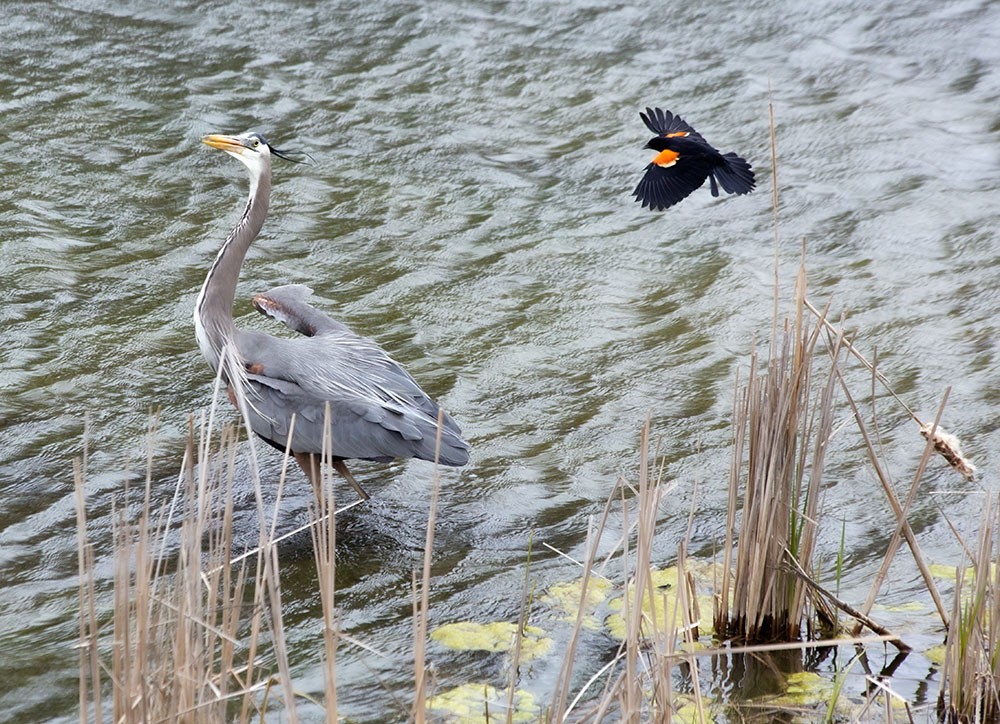 A red-winged blackbird chasing a heron at Elm Grove Village Park, photographed from a paved path, respecting nesting bird behavior.
A red-winged blackbird chasing a heron at Elm Grove Village Park, photographed from a paved path, respecting nesting bird behavior.
20. Overcoming Challenges in Ethical Wildlife Photography
Ethical wildlife photography can be challenging, requiring patience, skill, and a deep understanding of wildlife behavior. However, by anticipating potential challenges and developing strategies for overcoming them, you can increase your chances of capturing stunning images while minimizing disturbance.
20.1 Limited Access to Wildlife
One of the biggest challenges in ethical wildlife photography is limited access to wildlife. Many animals are shy or elusive and may be difficult to find or approach.
- Research Wildlife Habitats: Research wildlife habitats and identify areas where you are likely to find the animals you want to photograph.
- Use Tracking Skills: Develop tracking skills to help you locate animals in the field.



